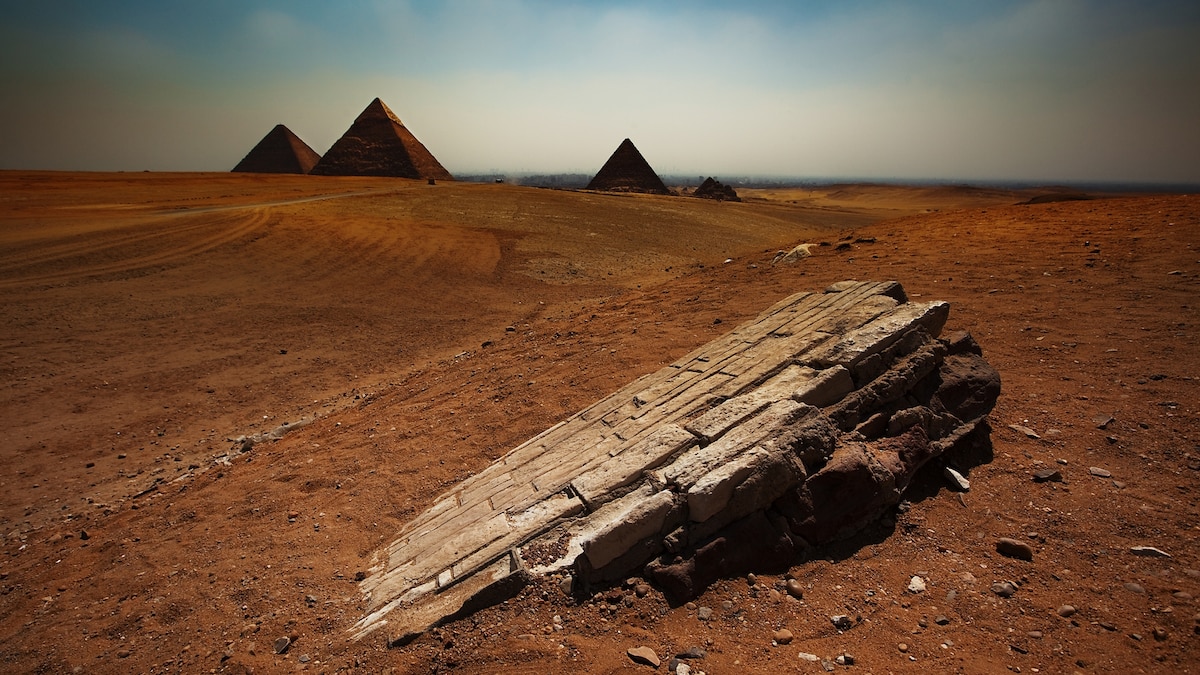Copyright National Geographic

So the pyramids might have been a kind of marine-industrial project, and what we now know as the sandblasted Giza plateau perhaps bordered a bustling harbor. It takes some getting used to. Those giant triangles in the desert—at once confounding to modern adults and relatable to preschoolers everywhere—have spawned so many crazy ideas that they long ago began to seem like primeval provocations. Some of this, including the persistent notion that these are alien deposits, was owed to the implausible sourcing and transport of so much raw material, hurdles that recede after the discovery of a lost branch of the Nile. But the pyramids’ final assembly instructions remain lost in the mail. We know only that they are uncannily aligned with the cardinal directions and that their bases are remarkably square, evidence of precision and mathematical savvy to match the apparent brawn. Or maybe no brawn was necessary. Consider the so-called Sleeping Prophet. About a hundred years ago, a Kentucky man named Edgar Cayce began branching out from the modest fame he’d achieved as a clairvoyant diagnosing patients while under hypnosis to the subject of the pyramids and the highly evolved souls who must have produced them. It came to him in a trance. They’d migrated from Atlantis, the ostensibly mythical island, before it sank. They chose Giza as an appropriate spot for a shrine, according to his vision, because it was at or near the center of the planet’s landmasses and therefore buffered from devastating quakes and floods. It wouldn’t just up and vanish like their homeland. We’re talking around 10,500 B.C. (The Pharaohs Khufu and Khafre and Menkaure, from this perspective, could be seen as merely several in a long line of latter-day opportunists, claiming the cool geometry for their own designs.) The stones were levitated through “the use of those forces in nature as make for iron to swim in the air,” Cayce intoned, while his secretary transcribed. Curiously, he also said that erecting the Great Pyramid took a hundred years, far longer than the 20 or 30 estimated by classical historians and present-day Egyptologists alike. (One might ask, What good is levitation if it’s so much slower than manual labor?) The placing of the capstone—long since missing, if it ever existed—was accompanied by a loud clanging of metal, Cayce said, to which we owe the tradition of church bells. Cayce was no longer alive when 1958 came and went. That was the year he’d said the science of levitation would be rediscovered. Supposedly there was a hall of records buried beneath the right forepaw of the Sphinx in Giza by Atlanteans who wished to document how it had all come to pass. Those secrets in the hall of records were what motivated a college dropout from North Dakota, Mark Lehner, to seek the counsel of Hugh Lynn Cayce, the prophet’s son, in the early 1970s. With funding and encouragement from the Cayce Foundation, Lehner then traveled to Egypt and resumed his studies, at the American University in Cairo. Thus began a decades-long career of investigation and excavation, in which Lehner seemed to find nothing more valuable than a love of painstaking, evidence-based research. He’s now one of the world’s foremost Egyptologists. From fringe to fastidious in a geological blink: Maybe the line was never as stark as we like to think. Lehner’s effort to test the Caycean chronology, in 1984, used radiocarbon dating of the interstitial organic matter between the stones: flakes of charcoal, for the most part. He thought the results puzzling, but not in a way that supported the levitation hypothesis. The charcoal was a few hundred years (but not seven or eight thousand years) older than Khufu. Might the pyramids’ builders have been burning old-growth forests for their mortar? To some, this left just enough uncertainty to sustain the guessing game. I wouldn’t necessarily have pegged myself as an ideal audience for such a boast. I was by then faintly familiar with the concept of “pyramidiots,” whose novel ideas included flying enormous kites to lift obelisks and making mini-rafts of inflated animal skins that could be lashed to large stones and then fed into a vast plumbing system employing locks to thwart gravity. Those sounded to me like Rube Goldberg fantasies. When contemplating the pyramids, I tended to shudder at the sheer scale of all that toil in the service of an ideal so limited that it boggled my secular-egalitarian mind. Providing a nice afterlife for the pharaoh, a man lucky enough to have been born rich? The majesty was almost an affront to my middle-age inclination to idleness. In this respect, I was a little like Pliny the Elder, the great Roman naturalist and author of the first encyclopedia, who gave us one of the oldest surviving accounts of the pyramids as seen through a tourist’s eyes. Publishing shortly after the profligate reign of Nero, in the first century A.D., Pliny criticized the transparent vainglory the Giza structures represented, the “superfluous and foolish display of wealth.” On the other hand, there was something appealingly democratic in the rise of an army of resourceful autodidacts against a gatekeeping archaeological establishment, and Larsen, who shared snippets of dispiriting correspondence with professors he’d emailed cold, was nothing if not well-read, sprinkling references to the inspiration he’d found in Isis knots and the slotted ends of djed pillars on the walls at Abydos. He was convinced that earthen ramps, favored by many academics as a likely means of escorting heavy material into thin air via sledge, were a nonstarter. Any ramp approaching Khufu’s upper reaches that was sufficiently gentle to allow dragging heavy blocks would be more voluminous than the monument itself and might extend a mile or more, surely leaving some archaeological trace. As with Cayce’s purported hall of records, why hadn’t anyone found anything? (Pliny, for what it’s worth, reported that he’d heard stories of salt-and-soda ramps, which could have been washed away by a flood, though he acknowledged that some of his contemporaries had a hard time believing this; the lost Nile branch wouldn’t be rediscovered for nearly 2,000 years.) “I don’t think the Egyptians could have made sandals fast enough to keep the work going,” Larsen said. I decided to take him up on his offer to prove the concept. The contraption was composed of logs that he’d sawed from a forest, along with lengths of knotted rope. (The ancient Egyptians were known to have imported cedars from Lebanon, Larsen noted.) It looked like a catapult, but with oars instead of a central lever—arguably a Herodotus machine, described only vaguely by the Greek historian, from his sources in the fifth century B.C., as having “short pieces of timber” and operating in a stepladder fashion. Larsen had assembled it in a backwoods borrow pit, at the top of a soft limestone embankment with a 48-degree slope—close enough, he figured, to the Great Pyramid’s 52. Taking in the scene, I half-expected to see Charlton Heston striding into view, hoisting the Ten Commandments. Like any pyramid architect, Larsen needed manpower. His own arms, he joked, were toothpicks, so he hired out for muscle by offering 50 bucks and stray favors to friends and acquaintances. I should note that these people all looked sane and genially skeptical. Soon he had a proper antediluvian construction site, with a soundtrack of grunting, creaking, and laughing. The creaking came from the ropes as several men attended to each oar, first walking it up and then pushing it back down a set of stairs flanking the main frame. The block slid up the track like a funicular in slow motion, a foot or two with each cycling of the oars. “It’s a little tedious, isn’t it?” Larsen said, admitting that several dozen such devices, and perhaps a few more sets of muscles on each oar, might be needed to meet the “rate of delivery” required of such a massive project if it were to be completed within a pharaoh’s lifetime. So many were the stones composing the Great Pyramid that Napoleon, who’d tasked a legion of savants with mapping the joint, is said to have quipped that they could be repurposed to form a 10-foot wall around the perimeter of France. (Almost true: As I’ve calculated it, the wall, perhaps fittingly, would have come up short.) But the atmosphere in Mississippi grew festive over the course of a couple of hours as Larsen’s block neared the embankment’s edge. Here stood a man who had willed into being, through the force of his own mania, a community effort so quixotic that it couldn’t help stirring wonder. I thought of the graffiti on chamber walls that modern scholars have attributed to Khufu’s construction gangs. Far from complaining, they seemed to be bragging. What drove Larsen and his makeshift crew may not have been so different from what motivated their predecessors in antiquity: a conviction that they were engaged in something rare, and in so doing were potentially slipping the bonds of time. The block reached the lip at last. Larsen proclaimed himself the first human in more than 4,000 years to achieve … this, whatever it was. One down (or up, rather), two million more to go. And now we were back at the crux of the pyramid saga, a story that is really less about technology than about patience, process, and follow-through, the stuff of which civilization is made. French Egyptologist Pierre Tallet had been sifting Egypt’s dirt for more than 20 years, a sizable pharaonic term, before he found the Red Sea Scrolls in 2013. You can’t expect to close your eyes and visualize the secret to an essentially political project any more than you can concentrate hard enough to levitate a rock. You need to keep digging, keep reading, keep wheedling, until one day the accumulation of all that effort will amount to something that our descendants can marvel at.



